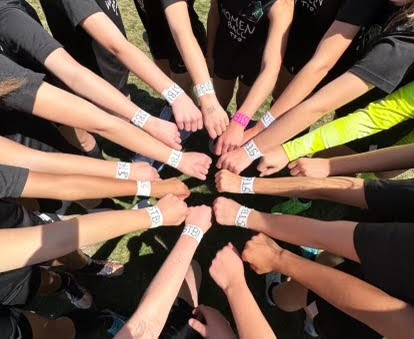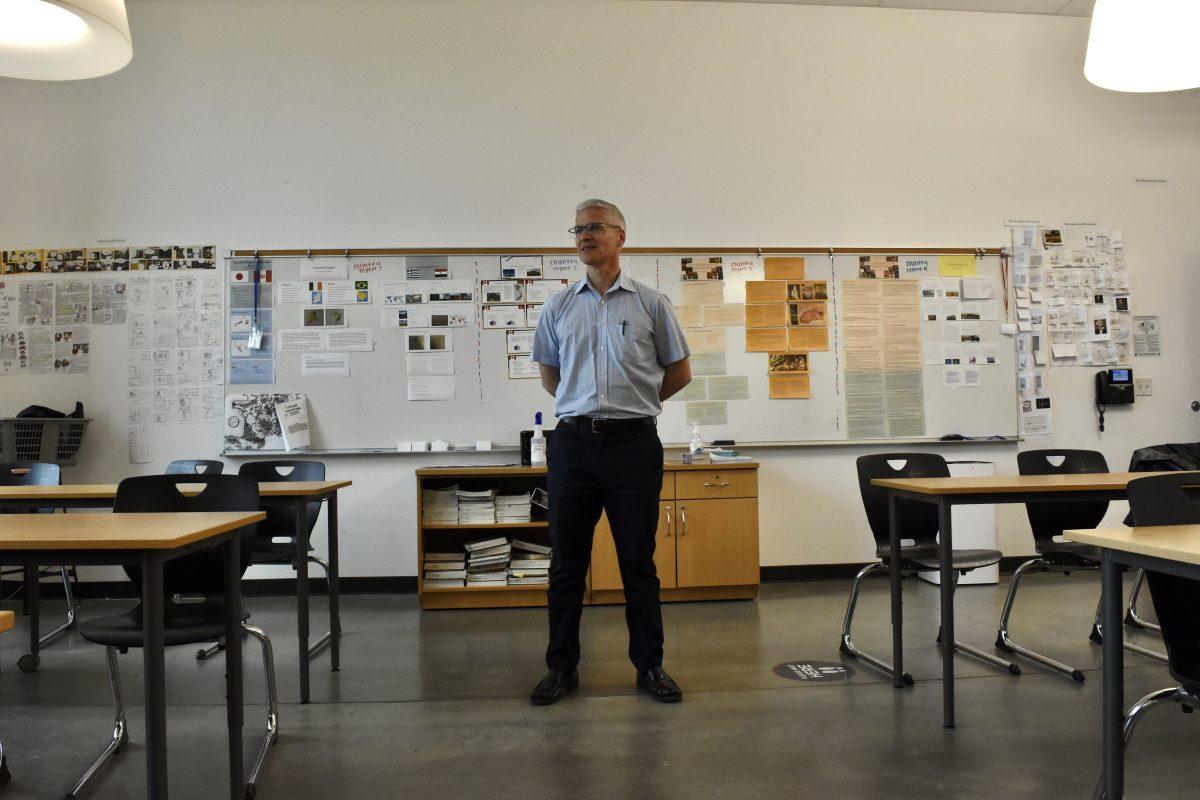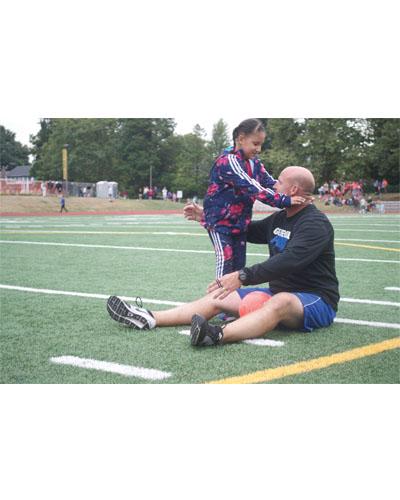
As I write, sophomore Grace Huffman is spending the month in Italy. She is not with relatives or on a school-sponsored trip, but instead swimming for eight hours a day in front of Olympic coaches.
Huffman is striving to prove herself at the 2019 synchronized swimming Olympic Development Program, reserved for only the most promising Olympic prospects hoping to gain professional-level swimming experience.
Huffman qualified for an invitation to the program as a result of her performance at the National Team Trials earlier this year. Placing 30th in the country for her age group, she joins her most focused competitors for three weeks of Team USA preparation.
When I first reached out to Huffman about setting up an interview, she let me know that although she would definitely make time to sit down with me, she was going to be trying to spend as much time in the pool as possible. This exchange took place in June, during the only two months out of the year considered part of the “offseason.”
This type of interaction is not out of the ordinary for Huffman. She swims as much as seven hours a day while preparing for competition and devotes over 15 hours a week on a regular basis. As national championships require increasingly demanding time commitments, Huffman often feels her relationships at school become strained and less consistent.
“I miss out on a lot of school things. I can’t do school sports usually because of the scheduling … and I miss a lot of my friends’ stuff,” she says. “Sometimes I’ll see people … going to the docks or having fun after school, and I’m like, ‘Oh, I’d like to do that.’”
Most high school athletes in her position may desire a less taxing practice schedule in favor of more time for social activities; Huffman, in contrast, opts for more practice time built into her weekly schedule.
In order to keep up with national competition, elite teams, especially those located in popular swimming markets such as California and Arizona, often demand more of their swimmers in terms of time dedication. As a result, these states often tend to receive much higher marks in national competitions and are seen as hotspots for Olympic team contenders and the country’s most well-renowned coaches.
Huffman hopes to eventually place top-10 in her age group and believes that her team’s raw talent would burgeon immensely with additional time in the pool. “I’d like to do more…A lot of the girls on my team are really good, and we’re consistently pushing to get more practice time because if we’re as good as we are without that amount of practice (that elite teams get), we could be really good if we did (get that) practice,” she says.

A catalog in the mail first introduced Huffman to synchronized swimming. She was only 7 when the Multnomah Athletic Club sent out an issue featuring the facility’s “MAC Synchro” program, the oldest synchronized swimming club in Portland that requires tryouts even for elementary-aged kids. Huffman’s mother, Ellen Wax, drove Huffman downtown to try out for the team the following fall, feeling the sport perfectly complemented her daughter’s coordination and love for being active.
“(Huffman) had enjoyed classes that included gymnastics, and also dance, and she also loved, loved, loved music (in) any form, and she loved being in the water … I just thought she was a strong athlete for a sport that had a big demand,” says Wax.
Though Huffman credits much of her physical confidence to synchronized swimming, she also recognizes that the sport is known to play a largely negative role in athletes’ body image.
“Synchro,” as the majority of its participants call it, is a judged sport, meaning that results are inherently subjective. Competition winners are decided upon by how the athlete or team looks, as opposed to objective factors such as time or goals scored.
“(The judging is) probably the most intense part of (synchro) because you’re a lot of times being judged on physical appearance, and so it’s like, ‘Well if you’re bad, there’s something you need to change,’ so it wears on a lot of girls,” says Huffman.
As the judging process for synchronized swimming benefits those with smaller lower-body structures, exercise routines for participants typically focus on leaning down, as opposed to gaining muscle.
Huffman enrolled in Grant’s CrossFit class her freshman year to fulfill her physical education requirement. Though students often view the course as one of the most athletically beneficial available, Huffman has struggled with body changes as a result of the constant weight training.
“(CrossFit) was really not helpful for me, because it made me build up a lot of muscle that I didn’t want, and so I’m actually working this summer to try to get rid of that; (it) seems really bizarre to try and get rid of muscle,” she says.
The most challenging part of gaining lower body muscle as a synchronized swimmer is that it immediately makes scoring high less attainable. Swimmers are judged based on how high their legs reach above the surface, and having more weight in the legs results in more difficulty during handstands and similar movements.
Huffman noticed her increasing amount of leg muscle throughout the school year and eventually began receiving lower scores as a result. Her duet partner, on the other hand, was excused from P.E. this year and typically scored higher than Huffman, due to both a naturally leaner build and significantly less lower-body muscle.
“We were always super close, but watching her and watching how I was doing, and watching also CrossFit affect my body how it did, was really bizarre,” says Huffman.
Throughout her freshman year, Huffman faced issues with body image as a result of becoming more aware of the builds of her competitors and teammates. Girls younger than her with less experience in the sport would score higher than her in competitions, often because of their body types. Long, lean legs typically appear to reach higher than more muscular ones, which allows some petite swimmers to level up more quickly than other girls. “I really became aware of girls that are really thin and really long,” Huffman says.
Huffman has also encountered this theme of comparison in areas outside of physical appearance. Her duet partner, who placed 14th at National Team Trials this year, is naturally smaller and is built differently than Huffman. However, she also takes more private lessons that are simply reserved for those who can afford them.
“Her family has more money than mine, and so she’d get a lot of (private lessons) and … she’d get a little better,” says Huffman.
Although Huffman has been impacted by the body image and comparison issues that come along with participating in synchronized swimming, she also recognizes the mental confidence and leadership skills she has gained from the sport.

“Being able to present myself and being able to go out and be like, ‘This is who I am, this is me,’ because when you swim, especially a solo, it’s just you … It’s definitely helped with (confidence),” says Huffman.
At this past season’s award ceremony, Huffman was voted Most Likely to Become a Coach by her team. “I think (synchronized swimming) also provides great leadership opportunities for the younger kids…She’s very much into helping the younger kids and mentoring them. So I think that meets a need of hers to be helpful. To help…young women,” says Wax.
While Huffman holds herself to high athletic standards, such as hoping to score in the top-10 at National Team Trials in the next few years, she realizes that her future won’t exclusively revolve around her success in swimming. As she’s now completed her final season in the 13-15-year-old age group, the next step is trying out for the Junior National Team. Those selected become part of an elite group just one level below the Olympic team and are required to change their lives entirely in order to begin training.
“I would try out for Junior National Team, but if I made it, I probably wouldn’t do it,” says Huffman. “You have to move down to California, you can’t do school, so you have to be homeschooled, and so you lose all your friends, and you don’t get to go to a school, so you can’t make new ones. And it’s with a bunch of girls that you don’t really know.”
Though Huffman has decided she likely won’t leave Grant to pursue competing at a higher level, she still finds herself prioritizing synchronized swimming over her school relationships and friendships. However, the bonds she has created within her team have proven just as reliable and necessary as her connections at school.
“We’re a really close-knit team,” says Huffman. Speaking to the decreased competitiveness of the 16 and over age group compared to younger ones, Huffman says, “You don’t have to try and beat each other, and you’re all working together.”
When her friendships at school become less consistent as swimming consumes more of her week, Huffman continues to credit her passion for the sport to the relationships she has created since first joining as a beginner. The support system her team has provided her with has helped her overcome struggles with confidence, even as it became challenging to resist comparing herself to her teammates.
As Huffman becomes a more competitive athlete, synchronized swimming has transformed into an increasingly physically demanding and mentally taxing hobby. Nevertheless, Huffman refuses to leave the sport in pursuit of a more elementary passion. “I don’t know what I’d do,” Huffman says at the suggestion of quitting. “It would be very bizarre. I don’t even know.” ♦



































